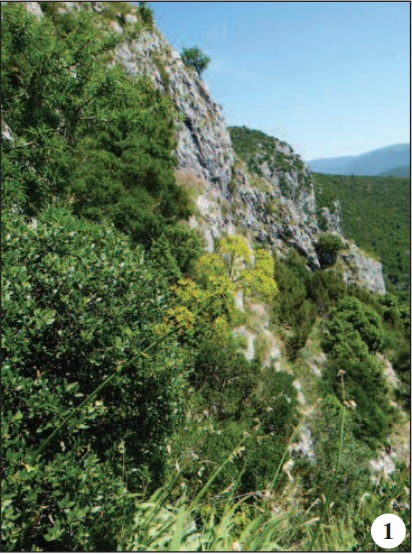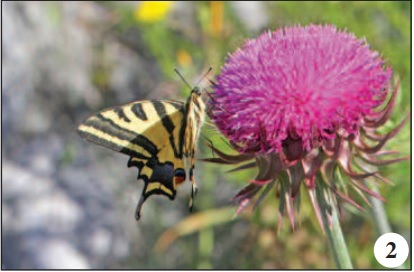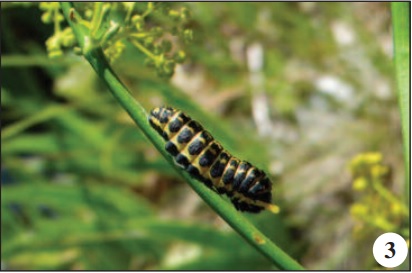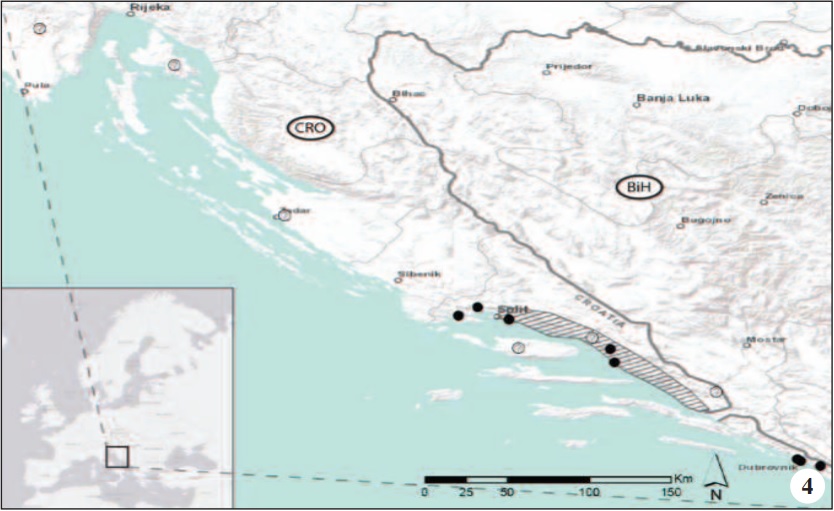

Confirmed recent occurrence of the Southern Swallowtail ( Papilio alexanor Esper, 1799) in Croatia (Lepidoptera: Papilionidae)
Confirmada la presencia reciente de la macaón meridional (Papilio alexanor Esper, 1799) en Croacia (Lepidoptera: Papilionidae)
Confirmed recent occurrence of the Southern Swallowtail ( Papilio alexanor Esper, 1799) in Croatia (Lepidoptera: Papilionidae)
SHILAP Revista de lepidopterología, vol. 44, núm. 176, 2016
Sociedad Hispano-Luso-Americana de Lepidopterología
Recepción: 06 Octubre 2015
Aprobación: 24 Noviembre 2015
Publicación: 30 Diciembre 2016
Abstract: Nearly five decades have passed since the last confirmed occurrence of the Southern Swallowtail (Papilio alexanor Esper, 1799) in Croatia. The species was not observed at any of the historical sites, but we found it at seven new sites between Split and the region south of the Neretva River. The habitat is very restricted and characterised by steep limestone rock faces with abundance of the larval host plant Opopanax chironium (L.) Koch. Due to severe fragmentation and continuing decline inferred from extinction of the species in historically known locations we consider the species as vulnerable (VU) in Croatia according to IUCN criteria.
Keywords: Lepidoptera, Papilionidae, distribution, habitat requirements, conservation, Croatia.
Resumen: Han pasado cinco décadas desde la última presencia confirmada de la macaón meridional (Papilio alexanor Esper, 1799) en Croacia. La especie no se ha observado en las localidades históricas, pero la encontramos en siete nuevos lugares entre Split y la región al sur del Río Neretva. El hábitat está muy restringido y se caracteriza por roquedos calcáreos en pendientes escarpadas con abundancia de la planta nutricia de las larvas, Opopanax chironium (L.) Koch. Debido a la severa fragmentación y el declive continuo, inferido por su extinción de las localidades conocidas en el pasado, consideramos a la especie como vulnerable (VU) en Croacia siguiendo los criterios de la UICN.
Palabras clave: Lepidoptera, Papilionidae, distribución, características del hábitat, conservación, Croacia.
Introduction
The Southern Swallowtail (Papilio alexanorEsper, 1799) is one of the most iconic butterfly species in Europe and has long captivated the interest of lepidopterists. Consequently its distribution and biology are well known throughout most of its range (KÖSTLER, 1991, BOLLINO & SALA, 2004, LAFRANCHIS et al., 2015). According to the catalogue of the collection of the Croatian national zoological museum in Zagreb (MLADINOV, 1973) the species was first discovered in Croatia in 1898 in the vicinity of Dubrovnik in southern Dalmatia. Subsequently it was reported from Gruz (a port near Dubrovnik) in the famous ‘Berge’s Schmetterlingsbuch’ (BERGE & REBEL, 1910), the exact locality possibly referring to slopes above the nearby village of Sustjepan (SCHWINGENSHUSS & WAGNER, 1928). Two additional records from Dubrovnik region at Mali Zaton (SCHWINGENSHUSS & WAGNER, 1928) and along the road from Mlini village to Cavtat (BURGERMEISTER, 1964) indicate a wider historical distribution of the species in southern Dalmatia. However, even BURGERMEISTER (1964) was unable to locate the population above Sustjepan, which he attributed to regular fires that have possibly destroyed the larval habitat. In addition to mentioned records Lorkovic indicates its general distribution in southern Dalmatia between Metkovic and Dubrovnik, but also explains that the species was never observed by any local entomologists in Croatia (LORKOVIC, 2009). According to BOLLINO & SALA (2004) the species was last recorded in southern Dalmatia in 1969 at Mali Zaton (ex coll. Krüger).
Further north P. alexanor was observed on the slopes of Mt. Kozjak above Kastel near Split by Stauder in 1907 (STAUDER, 1911) and at Trogir 10 kilometres further north (STAUDER, 1921). The same author reports failing to find the species in seemingly suitable habitat above Split, Mosor (STAUDER, 1911) and Biokovo Mountains (STAUDER, 1921), but anticipates its presence on Giovo and Brag islands (STAUDER, 1921). The latter was corroborated by Müller who found the species near Mirca village on Brag (MÜLLER 1921). It should however be noted that there are several dubious records in his publication which together with lack of listing of the much more common and widespread Papilio machaon Linnaeus, 1758 makes his observation unreliable (see WITHRINGTON & VEROVNIK, 2008). A single observation is noted also for Biokovo Mountains but without any detailed location information (NEUSTETTER, 1956). The author resided in Podgora on the south side of the mountains during his trip and saw the species on the way up to the mountains possibly near that village.
Apart from two apparent historical strongholds in Dalmatia the species was reported also from Zadar and Krk Island (BOLLINO & SALA, 2004) without any further details. Both records are hard to verify, but it seems unlikely that the species would not have been observed by Habeler who devoted several decades of surveys to the Lepidoptera of Krk Island (HABELER 2007). Additionally there is a record from central Istria at Pazin (STAUDER, 1913) where Austrian amateur lepidopterist Wilhelm Kraut from Graz collected several specimens. Unfortunately his material was never seen by Stauder or any other prominent lepidopterist, so there is room left for doubt. The species was not recorded during an extensive long term study of butterfly fauna of central Istria (KOREN & LADAVAC, 2010).
Due to lack of recent records, the Southern Swallowtail was presumed extinct not just in Croatia, but also in the entire former Jugoslavia (COLLINS & MORRIS, 1985). Regardless of that, the general field guides (e.g. LAFRANCHIS, 2004, TOLMAN & LEWINGTON, 2008) still reported its distribution in Istria and Dalmatia. Only a single report indicates a contiguous presence of P. alexanor in Dalmatia. It is listed from two altitudinal belts between zero and 1000 m on the north side of Biokovo Mountains (MIHOCI et al., 2011). However, it is not clear whether these are actual observations, or unknown historical records. Namely, the authors also list Zerynthia cerisy dalmacijae Sala & Bollino, 1994, which has not been observed in Croatia since its original description (SASIC & MIHOCI, 2011).
In order to confirm the presence of P. alexanor in Dalmatia the majority of known historical localities were visited by the first author in the last two decades, resulting in no new observations whatsoever. Based on firsthand experience with the habitat in neighbouring Montenegro, where the species has been recently rediscovered (SVARA et al., 2015), we decided to change the tactics and search for suitable habitats instead. Here we present new records for P. alexanor in Dalmatia and discuss behaviour, habitat selection, conservation status and potential threats for the species in Croatia.
New records
First adults of P. alexanor were observed at the beginning of May 2014 in the region south of Split on steep scree below rock faces. During a repeat visit to the region on 22nd of May 2014 we found the species at the site of the first observation and four additional localities. Typical habitat present at all sites where adults were observed is characterised by steep limestone rock faces with lush vegetation on adjacent slopes or scree (Fig. 1). The most important attribute of the habitat was, however, the abundance of larval host plant Opopanax chironium (L.) Koch, which was sometimes growing also in fissures on rock faces. Adults were gliding along rock walls, occasionally settling on flowers, predominantly large flowered thistles (Fig. 2) like Cirsium eriophorum (L.) Scopoli. Nectaring was observed also on Vicia cracca L. Adults were usually present in low numbers, at most up to five specimens were observed simultaneously. A surprising additional record arrived from a photo of P. alexanor taken on the southern slopes of Biokovo Mountains in 2014 (Zvonko Glibota, pers. comm.).
In the year 2015 we have widened our search, but with less success. A single specimen of P. alexanor was observed above Split in a seemingly suitable habitat, however without the presence of the host plant. More importantly we found the species also in southern Dalmatia just south of the Neretva River Valley. Here, we observed also first, second and third instar larvae of P. alexanor feeding on terminal and sub-terminal umbels of Opopanax chironium (Fig. 3). They were extremely numerous; up to 11 larvae could be counted on a single plant. Currently Opopanax chironium is the only known host plant of the species in Croatia as noted already by SCHWINGENSHUSS & WAGNER (1928). Several additional sites with suitable habitat and larval host plant were found in the region and should be monitored for the presence of adults or larvae in the future years.
Discussion
Despite several decades without any reliable records the Southern Swallowtail apparently survived in Dalmatia, but remained unnoticed. This could be attributed to lack of surveys in general in the region and also in particular for the species. Another important factor is scarcity of adults and extreme affiliation to their usually very localized and inaccessible larval habitat. Such distribution limitations are known throughout the range of the species (BOLLINO & SALA, 2004). It is therefore not surprising that we observed only a single, possibly wandering, specimen outside larval habitat on the slopes above Split. Even in this case it is likely that the larval habitat is somewhere in the vicinity, so further surveys in the area are required.
Given the known historical distribution, our records vaguely correspond to the southern and central Dalmatian centres of distribution, although there is almost no overlap with known historical distribution (Fig. 4). The records from Krk Island and Istria remain unverified, but the historical presence of the species in Istria cannot be entirely excluded, as the host plant Opopanax chironium is still present there (OTOPAL & KALIGARIG, 2012, FCB, 2014). The host plant is distributed also on Brag Island (FCB, 2014), so this is another region requiring further surveys. P. alexanor was recorded from neighbouring Herzegovina at higher altitudes (SCHAWEDRA, 1913, SIJARIC, 1970), so studies in Dalmatian hinterland could also provide additional records.
P. alexanor is listed as data deficient (DD) in the Red Data List of Croatian Butterflies (SASIC et al., 2013). Based on new observations this assessment could be modified to vulnerable (VU) under IUCN criteria (IUCN, 2001) B2ab (ii, iii, iv) – with area of occupancy of less than 500 km2, severe fragmentation and continuing decline inferred from extinction of the species in historically known locations. The species is strictly protected in Croatia (ANONYMOUS, 2009) so collecting of adults and larval stages is illegal. As majority of habitats where the species occurs are outside human impact, large scale collecting, especially of the larval stages is likely to be the most eminent threat to the species in Croatia. Therefore we hope the information provided here on the species habitat and distribution will not be misused for collecting purposes.




Agradecimientos
We would like to express our gratitude to Jernej Jogan and Peter Glasnovic for providing records of Opopanax chironium distribution in Croatia. We also thank Miguel Munguira for the translation of the abstract and useful comments on the manuscript.
BIBLIOGRAPHY
ANONYMOUS, 2009.– Ordinance on designating wild taxa protected and strictly protected (NN 99/09). (in Croatian)
BERGE, B. & REBEL, H., 1910.– Berg’s Schmetterlingsbuch nach dem gegenwärtigen Stande der Lepidopterologie neu bearbeitung und herausgabe von Professor Dr. H. Rebel. E: 509 pp. Schweizerbart, Stuttgart.
BOLLINO, M. & SALA, G., 2004.– Synopsis of Papilio alexanor Esper, 1799 (An updated revue of its taxonomy and biology): 64 pp. Natura edizioni scientifiche, Bologna.
BÜRGERMEISTER, F., 1964.– Makrolepidopteren aus dem Räume Dubrovnik (Süddalmatien, FVR Jugoslavien).– Zeitschrift der Wiener Entomologischen Gesellschaft, 49: 137-152.
COLLINS, N. M. & MORRIS, M. G., 1985.– Threatened swallowtails of the World: the IUCN red data book: 401 pp. IUCN Protected Area Programme Series, Gland, Switzerland and Cambridge, U.K.
FCB, 2014.– Flora Coratica Database. (Available from: http://hirc.botanic.hr/fcd/) (accessed 12th April 2014)
HABELER, H., 2007.– Die Schmetterlinge der Adria-Insel Krk: 221 pp. Entomologie Esperiana, Graz.
IUCN, 2001.– IUCN Red List categories and criteria: version 3.1.: 31 pp. IUCN Species Survival Commission, Gland.
LAFRANCHIS, T., 2004.– Butterflies of Europe: 351pp. Diatheo, Paris.
LAFRANCHIS, T., JUTZELER, D., KAN, P., KAN, B. & GUILLOSSON, J.-Y., 2015 .– La vie des Papillons de France: écologie, biologie et comportement des Rhopalocères de France: 752 pp. Diatheo, Paris.
LORKOVIC, Z., 2009.– The Rhopalocera fauna of Croatia with special respect to the fauna of Plitvice Lakes.– Entomologia Croatica, 13: 15-78.
KOREN, T. & LADAVAC, L., 2010.– Butterfly fauna (Lepidoptera: Hesperioidea & Papilionoidea) of Central Istria (Croatia).– Natura Croatica, 19(2): 369 -380.
KÖSTLER, W., 1991.– Ein Beitrag zur Biologie von Papilio alexanor maccabaeus Staudinger 1882 (Lepidoptera: Papilionidae).– Galathea, .(3): 82-89.
MIHOCI, I., HRSAK, V., KUGINIC, M., MIGETIC STANKOVIC, V., DELIC, A. & TVRTKOVIC, N., 2011.– Butterfly diversity and biogeography on the Croatian karst mountain Biokovo: Vertical distribution and preference for altitude and aspect? - European Journal of Entomology, 108: 623-633.
MLADINOV, L., 1973.– Lepidoptera (Rhopalocera) in collection of Croatian national zoological museum in Zagreb: 125 pp. Hrvatski narodni zooloski muzej, Zagreb. (in Croatian)
MÜLLER, H., 1921.– Vier Wochen auf der Insel Brazza.– Entomologischer Anzeiger, .: 4-6, 17-18.
NEUSTETTER, H., 1956.– Sammelreisen nach Dalmatien (Jugoslaviën).– Entomologisches Nachrichtenblatt, .(3):4-8.
OTOPAL, J. & KALIGARIG, M., 2012.– Botanical rarities from Slovenian Istria.– Annales - Series historia naturalis, 22(2): 139-144.
SCHAWEDRA, K., 1913.– Siebenter Nachtrag zur Lepidopterenfauna Bosniens und der Herzegowina.– Verhandlungen der kaiserlich-königlichen zoologisch botanischen Gesellschaft in Wien, 63: 141-178.
SCHWINGENSCHUSS, L. & WAGNER, F., 1925.– Beitrag zur Macro-Lepidopteren-Fauna Süddalmatiens insbesondere der Umgebung Gravosa‘s.– Zeitschrift des Österreichischen Entomologischen Vereins, 10(6): 53- 57, 66-71, 78-82, 116-119.
SIJARIC, R., 1970.– Fauna Rhopalocera and Hesperioidea (Lepidoptera) in the region of primeval forestPerucice in mountain complex Maglic, Volujak and Zelengora.– Glasnik Zemaljskog muzeja, Sarajevo, .: 186-191. (in Serbo-Croatian)
STAUDER, H., 1911.– Beiträge zur Kenntnis der Makrolepidopteren-fauna der adriatischen Küstengebiete.– Bollettino della Società Adriatica di Scienze Naturali in Trieste, 25(2): 93-120.
STAUDER, H., 1913.– Weitere Beiträge zur Kenntnis der Makrolepidopterenfauna der adriatischen Küstengebiete.– Bollettino della Società Adriatica di Scienze Naturali in Trieste, 27(1): 105-166.
STAUDER, H., 1921.– Die Schmetterlingsfauna der illyro-adriatischen festland- und inselzone (faunula illyro- Adriatica).– Zeitschrift für wissenschaftliche Insektenbiologie Berlin, 16(1/2): 16-23, (3/4): 43-49, (5/6): 101- 108, (7/8): 143-153, (9/10): 166-176, (11/12): 219-224.
SASIC, M. & MIHOCI, I., 2011.– Annotated checklist of Croatian butterflies with vernacular names.– Natura Croatica, 20(2): 425-436.
SASIC, M., MIHOCI, I. & KUGINIC, M., 2013.– The Red Data List of Croatian Butterflies. In D. MARKOVIC (ed.). Drzavni zavod za zastitu prirode, Ministarstvo zastite okolisa i prirode, Zagreb. (Available from: http://www.dzzp.hr/dokumentizupload/20130823/dzzp201308231558360.pdf) (accessed 15th September 2015).
SVARA, V., ZAKSEK, B. & VEROVNIK, R., 2015.– Contribution to the knowledge of the butterfly fauna of Montenegro (Lepidoptera: Rhopalocera).– Acta entomologica Slovenica, 23(1): 37-48.
TOLMAN, T. & LEWINGTON, R., 2008.– Butterflies of Britain & Europe: 384 pp. Harper Collins Publishers, London.
WITHRINGTON, D. & VEROVNIK, R. 2008.– Butterflies (Rhopalocera) of the Croatian islands.– Entomologist’s Gazette, 59: 3-25.